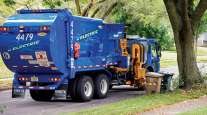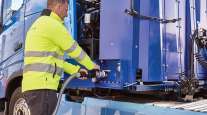Special to Transport Topics
Eaton, BAE Systems Partner on E-Powertrain Offerings
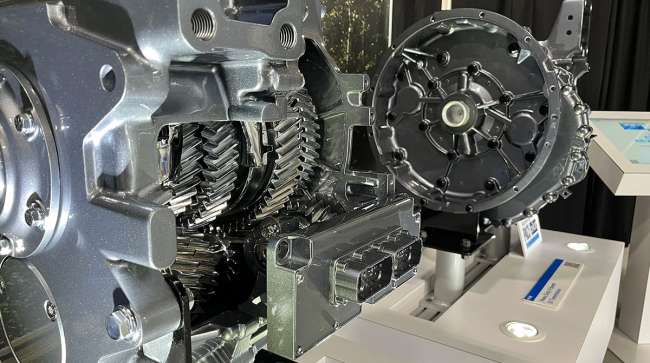
[Stay on top of transportation news: Get TTNews in your inbox.]
MARSHALL, Mich. — Eaton Corp. and BAE Systems, through an expanded partnership, provided a demonstration of their powertrains and charging solutions for medium-duty electric vehicles and plan to introduce a heavy-duty model as soon as next year.
The ride-and-drive event for fleet owners and OEMs was held at Eaton’s Proving Grounds on June 13.
An initial memorandum of understanding was signed between the companies to collaborate on a medium-duty battery-electric vehicle last year. In May, the partnership was expanded to include heavy-duty BEVs.
The medium-duty powertrain is an electric motor mounted on the underside of a CL7 Freightliner M2 and the newly developed, 4-speed transmission designed exclusively for BEVs. The system was designed with simplicity in mind, said Tom Webb, director of business development and strategy, power and propulsion solutions for BAE. He noted that while the demonstrator model uses the newly developed powertrain, other parts are standard across the industry.
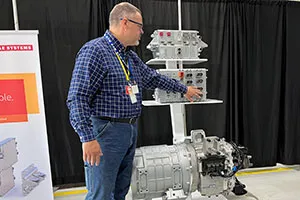
"Any electric vehicle, we think of as two systems," says BAE's Derek Matthews. (Amanda Smith-Teutsch for Transport Topics)
“Consolidate and simplify,” Webb said. “That is kind of our mantra.”
The engineers reimagined the traditional BEV power system, said Derek Matthews, global partnership manager, power and propulsion systems for BAE.
“Any electric vehicle, we think of as two systems,” Matthews said. “Accessory systems for all your air brakes, power steering, air conditioning — accessory loads. Then we look at the other part — main power loads.”
Matthews added that this enables BAE to eliminate a great deal of the meters of high-voltage cabling strung through most BEVs and greatly simplify the truck’s internal electrical system.
Webb also noted the multigear automated transmission and the direct-drive propulsion systems BAE has deployed worldwide.
“The gearbox helps significantly when looking at the truck space, where you get 70 miles an hour, you have to do some serious grades,” he said. The 4-gear transmission allows BEV trucks to operate at or close to the capabilities of a truck with an internal combustion engine, Webb explained.
Derek Matthew’s with @BAESystemsInc discusses the capabilities of the new multi speed BEV transmission. pic.twitter.com/xGnFCFDwgi — Amanda Smith-Teutsch (@ASmithTeutsch) June 14, 2024
During the drive demonstration, the zero-emission truck showed off its paces, reaching highway speeds on the test track fully loaded at 33,000 pounds, and pulled up to 30% incline. The truck has a feature that prevents it from freely rolling backward downhill from a standstill and uses regenerative technologies to charge the battery while braking or coasting downhill.
Eaton offered different EV charging options from the company’s scalable busway charging system to traditional wall-mounted panels.
Sai Murahari, EVCI product manager for Eaton, demonstrated the scalability of one charging system, which plugs into a busway mounted to the ceiling of a fleet garage. Power cables then dangle down from overhead to allow for vehicle charging. He explained that busways have been used to power high-rises and factories for decades; the company integrated an EV charger into a plug-and-play system that’s immediately scalable.
“This avoids digging, this avoids trenching and gives a completely overhead EV charging solution,” Murahari said “You can have a bus track laid out in your existing facility and scale your EV charging as your fleet grows.”
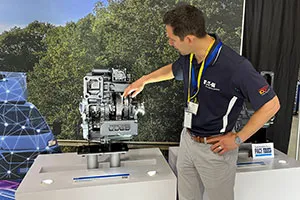
Justin Hopkins of Eaton says fleets' concerns have centered on chargeability and affordability. (Amanda Smith-Teutsch for Transport Topics)
Justin Hopkins, product director of ePowertrains for Eaton, said feedback concerns have centered on chargeability and affordability.
“Having charging capability is the first thing people bring up. It’s a limitation for fleets to be comfortable adopting it,” he said. “The other thing is making sure it’s cost-effective. From a vehicle perspective, making sure it’s going to be light enough from a weight perspective to be useful.”
From a total-cost-of-operation perspective, Hopkins noted BAE will bring a “very modularized, highly integrated solution that can bring the cost down as well as the long-term maintenance.”
BAE’s Matthews said the trucks are engineered to be modular, where battery ports and inverters are arranged in compartmentalized blades that can be swung out and replaced quickly if there’s a problem, meaning less downtime for the truck.
Matthews said the research teams are moving ahead with further development, taking what they’ve learned with the medium-duty powertrain and are gearing up for a heavy-duty model, which will be demonstrated next year.
“It’s all built off the same architecture,” Matthews said. “Just a Class 8 solution, 4-speed transmission, hooked up to an electric machine that didn’t get a lot bigger, but now can do 80,000 pounds instead of 33,000 pounds.”
Want more news? Listen to today's daily briefing below or go here for more info:


